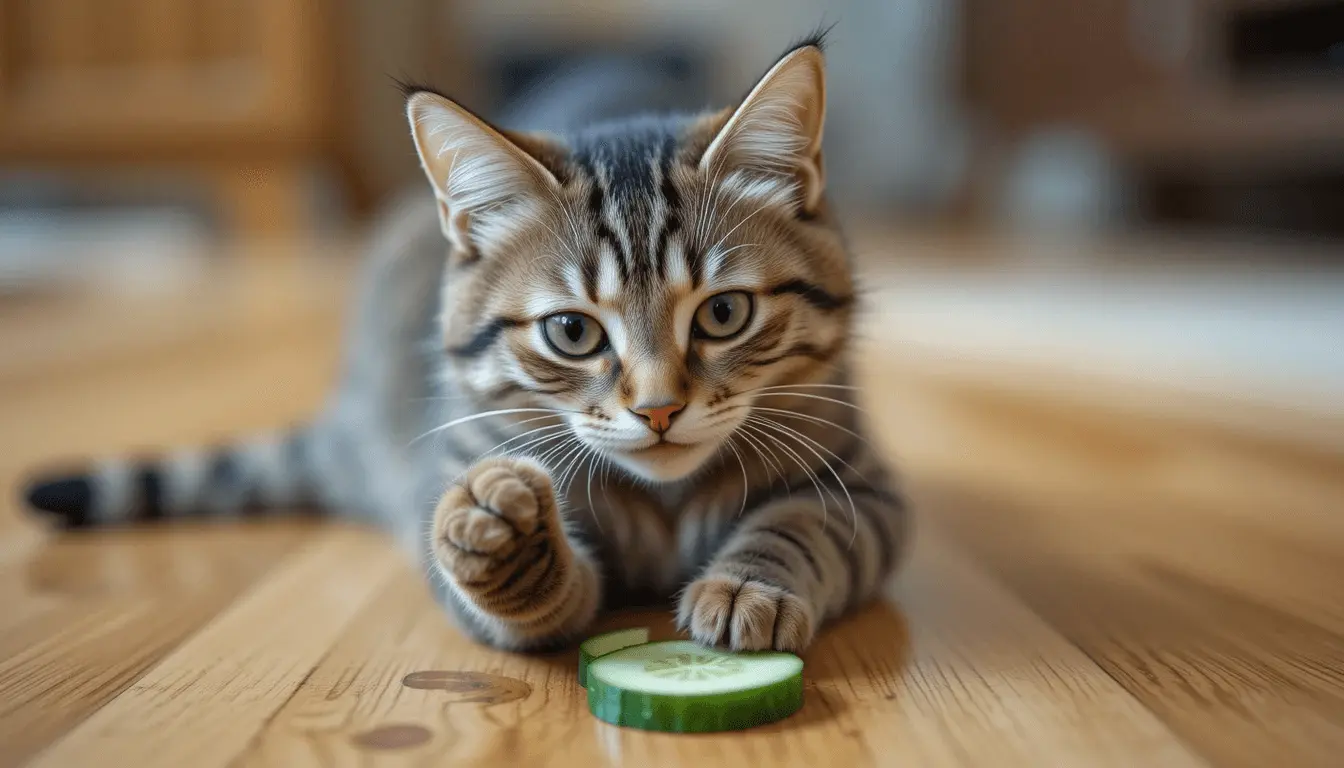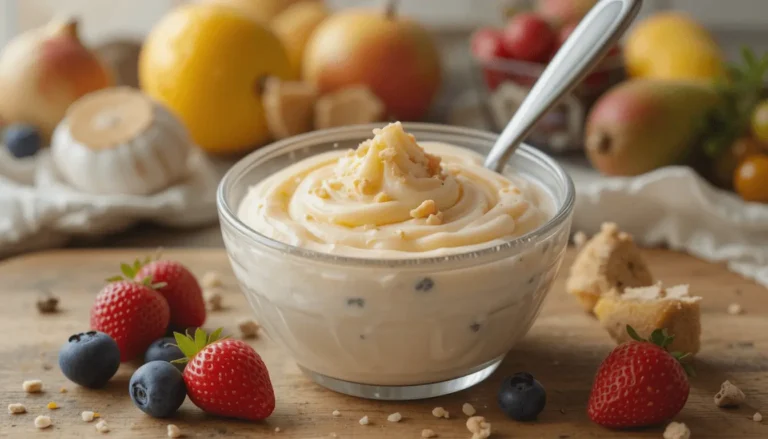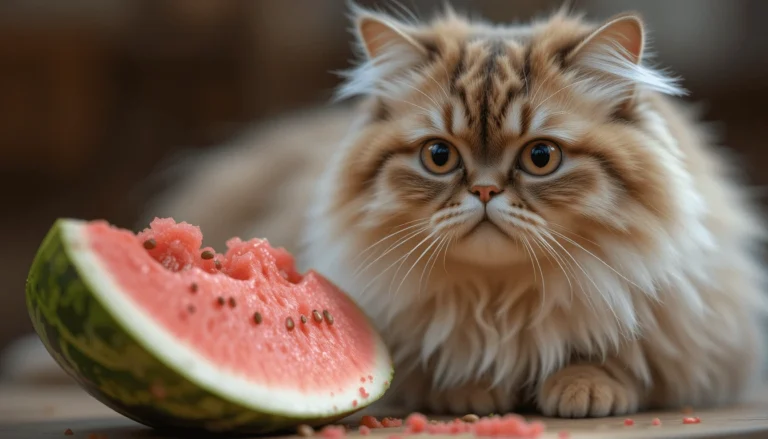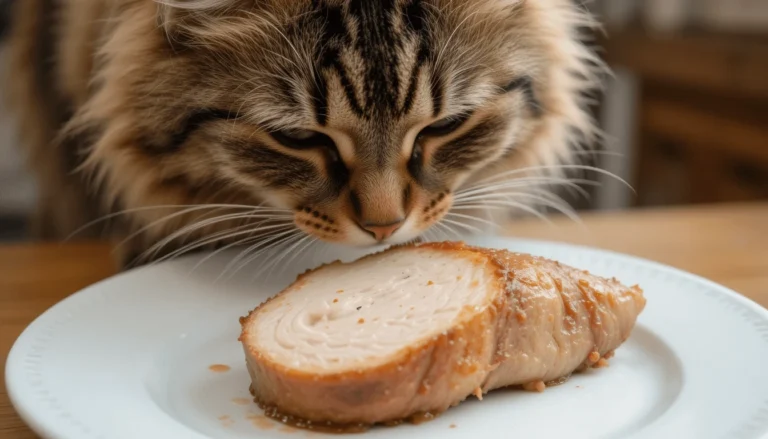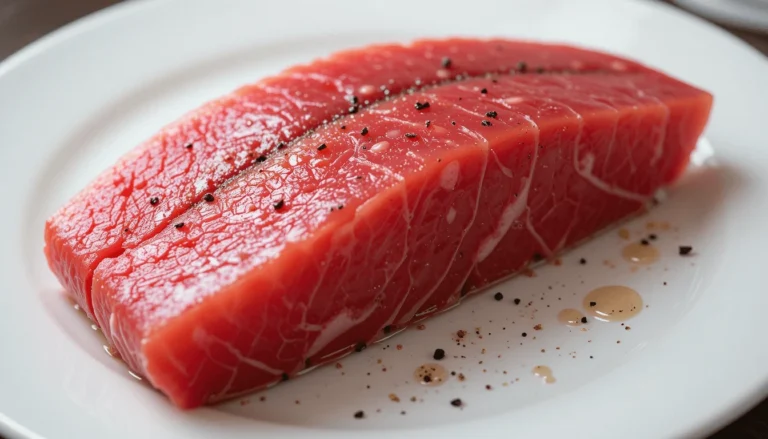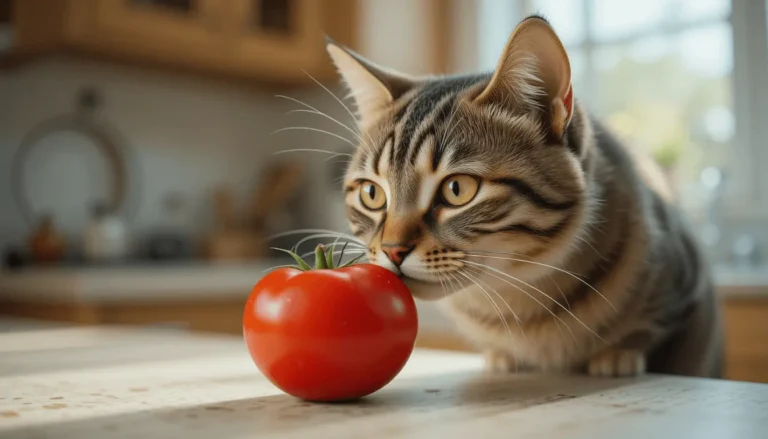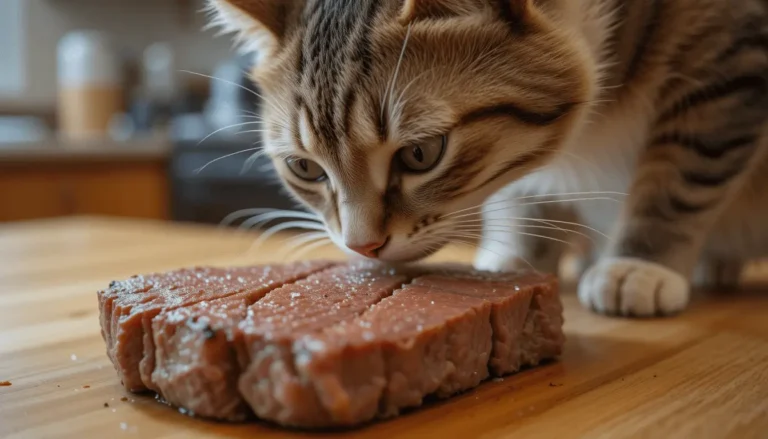Can Cats Eat Cucumber? Vet-Approved Facts & Tips
Introduction
“It started with a crunch. My cat, Whiskers, froze mid-step, ears twitching toward the kitchen counter where I’d just sliced a cucumber for my salad. Before I could blink, he’d leaped up, sniffed the green slices with suspicion… then batted one onto the floor like a tiny hockey puck. But can cats eat cucumber? Or was his curiosity a recipe for disaster?”**
As cat owners, we’ve all been there—watching our feline friends eye our snacks with a mix of fascination and disdain. Cucumbers, with their mild flavor and high water content, seem harmless enough. But between viral videos of cats “jumping scared” from cucumbers and conflicting advice online, it’s hard to know what’s safe.
In this vet-approved guide, we’ll slice through the myths and uncover the truth: Are cucumbers a hydrating treat or a hidden hazard for cats? You’ll learn:
- ✅ The science-backed safety checklist (spoiler: most cats can nibble cucumber—with caveats).
- 🚨 The real reason some cats freak out over cucumbers (hint: it’s not the veggie itself).
- 🥒 Pro tips to serve cucumber safely—plus cat-approved veggie alternatives.
Let’s settle the debate once and for all!
Is Cucumber Safe for Cats?
If you’ve ever caught your cat curiously sniffing your salad, you’ve probably wondered: Is cucumber safe for cats? The good news is that cucumbers are generally non-toxic to felines, but there are some important details every cat owner should know before sharing this crunchy snack.
Nutritional Value of Cucumbers for Cats
Cucumbers are often considered one of the safest vegetables for cats due to their simple composition. Here’s what makes them a low-risk treat:
- Low in calories – With only about 16 calories per cup, cucumbers won’t contribute to feline obesity, making them a decent snack for weight-conscious cats.
- High water content (96%) – A great way to help hydrate cats who don’t drink enough water, especially in hot weather.
- Vitamins K & C – While cats don’t require plant-based vitamins, small amounts can support overall health.
- Fiber boost – May aid digestion in cats prone to mild constipation.
However, since cats are obligate carnivores, cucumbers provide no essential nutrients they can’t get from meat. Think of them as an occasional crunchy treat—not a dietary staple.
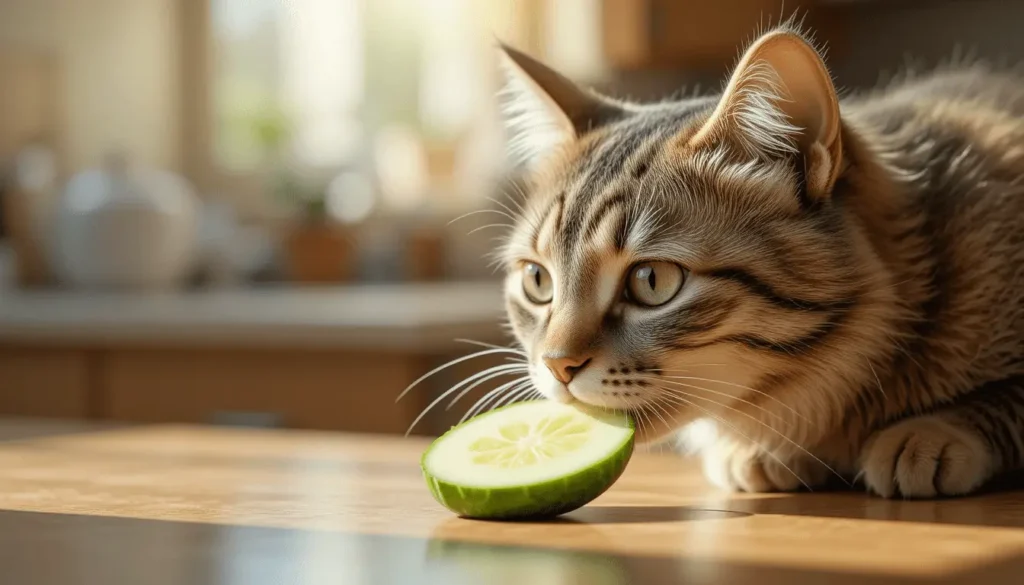
Potential Risks of Feeding Cucumber to Cats
While cucumbers aren’t poisonous, they do pose a few risks:
- Choking hazard – Large, unpeeled slices can get stuck in a cat’s throat. Always cut into small, bite-sized pieces.
- Digestive upset – Some cats may experience vomiting or diarrhea if they eat too much. Introduce slowly and monitor their reaction.
- Pesticide exposure – Non-organic cucumbers may contain harmful chemicals. Always wash thoroughly or peel before offering any to your cat.
If your cat has a sensitive stomach or a history of food allergies, it’s best to skip cucumbers altogether and stick to vet-approved treats.
Why Are Some Cats Scared of Cucumbers?
You’ve likely seen those viral videos where cats jump in terror at cucumbers placed behind them. But why does this happen?
- Sudden object reaction – Cats are hardwired to detect potential threats. A cucumber appearing out of nowhere triggers their prey-flight instinct.
- Snake-like appearance – Some experts suggest the shape and color may resemble a snake, causing an automatic fear response.
- Stress factor – Deliberately scaring a cat with cucumbers can lead to long-term anxiety, so it’s best to avoid this “prank.”
Final Verdict: Can Cats Eat Cucumber?
Yes—in small, prepared amounts, cucumber is safe for most cats. But since it offers no real nutritional benefit, it should remain an occasional snack, not a regular part of their diet. Always supervise your cat when introducing new foods, and consult your vet if you’re unsure.
Want to explore more cat-safe veggies? Check out the ASPCA’s list of non-toxic plants for other safe options.
How to Safely Feed Cucumber to Your Cat
Now that we’ve established that cats can eat cucumber in moderation, let’s talk about how to serve this veggie the vet-approved way. While cucumbers aren’t dangerous, proper preparation and portion control are key to keeping your feline friend safe and happy.
Proper Serving Size & Preparation
To minimize any risks (like choking or digestive upset), follow these simple steps:
- Wash thoroughly – Rinse the cucumber under cold water to remove any pesticide residue. Organic cucumbers are ideal.
- Peel the skin (optional) – While not toxic, the tough outer skin can be hard to digest. Peeling makes it easier on your cat’s stomach.
- Cut into tiny, manageable pieces – Slice into small, bite-sized cubes (about ¼-inch) to prevent choking. Avoid large slices or whole chunks.
- Start with a test portion – Offer just 1-2 small pieces and wait 24 hours to check for any adverse reactions (vomiting, diarrhea, or lethargy).
⚠️ Never leave a whole cucumber slice unattended—supervise your cat while they snack to ensure they’re chewing properly.
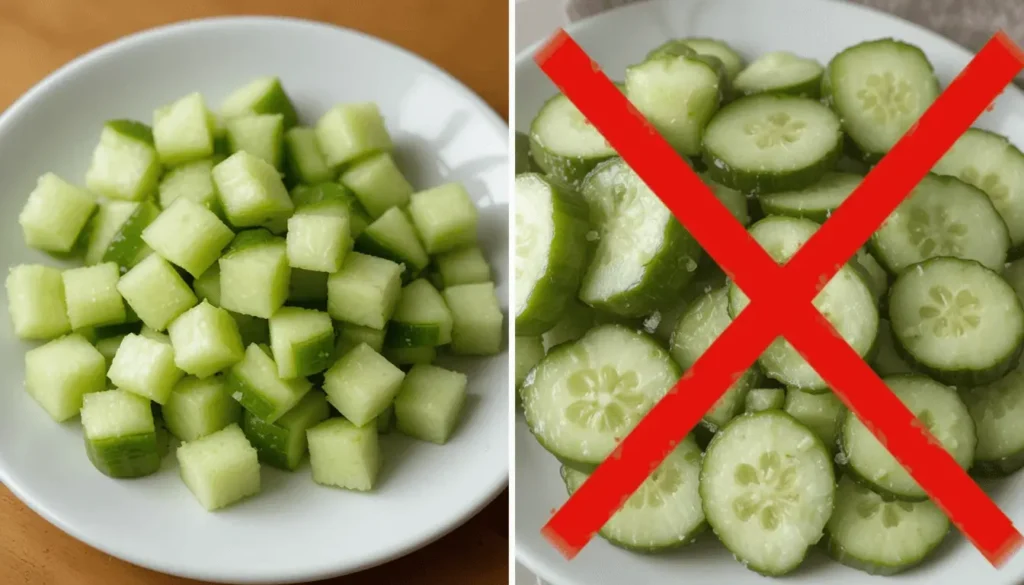
Signs Your Cat Likes (or Hates) Cucumber
Not all cats will be fans of this watery veggie. Here’s how to tell if yours is into it—or totally unimpressed:
✅ Positive reactions (they might like it!)
- Sniffing curiously before taking a bite
- Gentle nibbling or licking
- Playfully batting a cucumber slice around like a toy
❌ Negative reactions (they’re not a fan)
- Walking away or ignoring it completely
- Hissing, swatting, or backing up (especially if startled by its shape)
- Covering it with their paw (a cat’s way of saying, “Get this away from me”)
If your cat falls into the latter group, don’t force it—cucumber isn’t a must-have in their diet.
Creative Ways to Serve Cucumber to Cats
Want to make cucumber more appealing? Try these fun (and safe!) serving ideas:
- Mix with wet food – Dice a few tiny pieces and stir into their favorite pâté. The familiar smell might encourage them to try it.
- Frozen cucumber chips – Freeze thin slices for a cool, crunchy summer treat (great for teething kittens!).
- Stuff a puzzle feeder – Hide small cucumber bits in an interactive toy to make snack time more engaging.
- Blend into cat-friendly smoothies – For adventurous eaters, blend cucumber with a bit of plain chicken broth (no onions or garlic!) and freeze into lickable cubes.
💡 Pro Tip: If your cat turns up their nose at plain cucumber, try rubbing a tiny bit of tuna water or salmon juice on it to boost the aroma.
Final Thoughts on Feeding Cucumber to Cats
While cucumber is safe for most cats, it’s best served as an occasional treat—not a dietary staple. Always prioritize your cat’s preferences and monitor for any digestive issues. If you’re unsure about a new food’s safety, your veterinarian can provide personalized guidance for your cat’s diet.
Looking for more vet-approved snack ideas? For science-backed recommendations, consult the Cornell Feline Health Center’s research on incorporating produce into cat nutrition.
Other Cat-Safe Vegetables & Alternatives
While cucumber is generally safe for cats in small amounts, it’s not the only human food your feline might enjoy—or the most nutritious. If you’re looking to add variety to your cat’s treats (without risking their health), here’s what you need to know.
Best Vegetables for Cats (Besides Cucumber)
Cats don’t need vegetables, but a few vet-approved options can provide fiber, vitamins, and hydration in moderation. These include:
- Cooked carrots – Soft, steamed carrot pieces (no seasoning) are safe and contain beta-carotene, which supports eye health.
- Steamed broccoli – Small florets are packed with antioxidants, but too much can cause gas—so serve sparingly.
- Zucchini – Mild and easy to digest, especially when peeled and cooked. Many felines will happily nibble on small, uncooked portions.
- Peas – Often found in commercial cat foods, plain peas (fresh or frozen) are a safe source of plant protein.
- Pumpkin (plain, cooked) – A digestive superstar for cats with constipation or diarrhea (just ½ tsp mixed into food).
⚠️ Important: Always introduce new veggies one at a time and in tiny amounts (about a teaspoon). Be sure to discard leftovers within 20 minutes to prevent bacterial growth.
Foods to Avoid Feeding Your Cat
While some human foods are safe, others are dangerous—even deadly—for cats. Steer clear of:
Allium Vegetables (Onions, Garlic, Chives)
- Toxic Effect: Induces oxidative damage to red blood cells, leading to potentially fatal hemolytic anemia
- Clinical Signs: Weakness, pale gums, rapid breathing
Grapes & Raisins
- Toxic Effect: Nephrotoxic substance (unknown compound) causing acute kidney injury
- Clinical Signs: Vomiting, lethargy, decreased urine production
Avocado
- Toxic Component: Persin (fungicidal toxin in pit, skin, and leaves)
- Clinical Effects: Gastrointestinal irritation, myocardial damage in severe cases
Nightshade Vegetables (Raw Potatoes, Green Tomatoes)
- Toxic Alkaloid: Solanine (concentrated in green parts and sprouts)
- Health Risks: Neurological symptoms, gastrointestinal distress
Methylxanthines (Chocolate, Caffeine)
- Toxic Mechanism: Adenosine receptor antagonism
💡 Surprising Risk: Even small amounts of alcohol or xylitol (found in sugar-free gum) can be fatal. Carefully review all ingredient lists before offering people food to your feline companion.
When to Consult a Vet About Your Cat’s Diet
Most cats handle small veggie treats fine, but watch for these warning signs after feeding cucumber (or any new food):
- Vomiting or diarrhea lasting more than 24 hours
- Lethargy or loss of appetite
- Adverse reactions may include facial edema, pruritus, or dyspnea indicating potential anaphylaxis
- Choking or gagging (if a piece was too large)
🚨 Act fast if you notice:
→ Tremors, seizures, or collapse (indicate severe toxicity—rush to the ER vet).
Prevention Tip: Keep a list of what your cat ate (and how much) to help your vet diagnose any issues quickly.

Final Verdict: Veggies as Cat Treats
Though cat-friendly vegetables like cucumber can make enjoyable treats, they must remain supplemental to your cat’s primary meat-focused diet. Essential guidelines include:
Wash and prepare properly (cooked/peeled if needed).
Start with tiny portions (1-2 small pieces).
Monitor for reactions—when in doubt, skip it!
Want a vet’s take? The Merck Veterinary Manual offers detailed guides on feline nutrition and toxic foods.
Conclusion: Can Cats Eat Cucumber? The Final Answer
So, can cats eat cucumber? The answer is yes—in small, properly prepared amounts, cucumber is a safe and hydrating occasional treat for most felines. While harmless, this vegetable doesn’t provide the animal-based nutrients essential for a feline’s biological needs. The key is moderation and supervision: always wash, peel, and cut into tiny pieces to prevent choking, and never force it if your cat isn’t interested.
Remember, not all human foods are cat-friendly. While cucumber, steamed carrots, and zucchini get a paws-up, avoid toxic foods like onions, garlic, and grapes. And if your cat shows any signs of digestive upset or allergies, stop feeding the new food and consult your vet.
Want to learn more about cat nutrition and safe treats? Check out these trusted resources:
- Safe Or Not ? Cat Food Guide – What’s safe and what’s dangerous
- ASPCA’s Toxic and Non-Toxic Plants List – A must-read for pet owners.
- Cornell Feline Health Center’s Dietary Guide – Vet-approved feeding tips.
At the end of the day, every cat is different—what’s your feline’s favorite healthy snack? 😸
FAQs
1. Can cats eat cucumber skin?
While cucumber skin isn’t toxic, it can be tough for cats to digest and may contain pesticide residue. For safety, peel the cucumber before offering it to your cat, especially if it’s not organic.
2. Is cucumber good for cats with kidney disease?
Cucumber’s high water content (96%) can help with hydration, which is beneficial for kidney health. However, always consult your vet first, as some cats with kidney issues may need strict dietary control.
3. Why do cats freak out when they see cucumbers?
The viral “cucumber scare” happens because cats mistake the sudden appearance of a cucumber for a snake or predator. It triggers their instinct to flee—not because cucumbers are dangerous, but because the surprise stresses them. Avoid this “prank,” as it can cause anxiety.
4. How much cucumber can I give my cat?
A few small, bite-sized pieces (about 1-2 teaspoons) once or twice a week is plenty. Overfeeding can lead to digestive upset or dilute essential nutrients in their diet.
5. Can kittens eat cucumber?
Kittens can try tiny amounts, but their digestive systems are more sensitive. Always peel, chop finely, and supervise to prevent choking. Focus on high-protein kitten food for proper growth.
6. Are pickles safe for cats?
No! Pickles contain salt, vinegar, garlic, and spices, which are harmful to cats. Stick to plain, fresh cucumber only.
7. What if my cat vomits after eating cucumber?
Stop feeding cucumber and monitor for 24 hours. If vomiting continues, or if your cat acts lethargic, contact your vet. It may indicate a sensitivity or unrelated health issue.
8. Can cats eat cucumber seeds?
The seeds aren’t toxic but can pose a choking risk or cause minor stomach irritation. Remove them if possible, or stick to seedless varieties.

